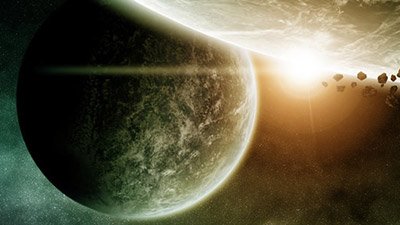
Extrasolar Planet Now Hottest Ever Discovered
If Earth’s neighbor Venus—known for high pressure, high temperatures, and toxic gases—sounds unwelcoming, wait till you learn about planet WASP-12b.
News Source
- LiveScience: “Hottest Planet Ever Discovered”
WASP-12b is one of the newest extrasolar planets discovered. A gas giant twice as large as Jupiter, the largest planet of our solar system, WASP 12-b is so close to its star that it orbits about once a day!
As far as space tourism goes, don’t expect trips to the planet anytime soon. For one thing, the planet is 870 light-years away. But more important is that the planet is thought to be around 4,000˚F (2,200˚C)—perhaps slightly balmier than what summer vacationers would normally prefer!
LiveScience author Clara Moskowitz asks, “[D]iscoveries like this raise the question, are planets like this in fact more common in the universe than planets like Earth?” Don Pollacco of Queen’s University in Northern Ireland answers:
Is our solar system the freak, or are these other solar systems the freaks? Who knows? I suspect that for life to evolve as we know it, you have to have a special set of circumstances come together to produce very specific conditions.
Pollacco is a project scientist for SuperWASP (Super Wide Angle Search for Planets), the team that originally discovered WASP-12b. It’s important to keep in mind that, with current technology, astronomers can’t actually observe extrasolar planets. Rather, they use indirect methods to infer the existence of such planets and extrapolate facts about them, such as size and mass. The most common method of detection is to observe the wobble of a distant star as orbiting planets exert gravitational pull. The less common method used to detect WASP 12-b is to track dips in the brightness of stars as orbiting planets temporarily obscure the view from Earth.
WASP 12-b is so close to its star that it orbits about once a day!
What’s certain is that discoveries of extrasolar planets are continuing reminders of how unique Earth is. Even the few “Earth-like” extrasolar planets discovered prompt the question, why is Earth so special?
Unsurprisingly, evolutionists hold on to their faith that eventually other Earth-like planets—with signs of life—will be found, confirming the evolutionary tale. Even when the rest of the solar system turned up devoid of life, the search just moved out into the rest of the galaxy. Our guess is that even if the entire Milky Way galaxy was shown to be devoid of life, evolutionists would just await the day when extra-galactic planets could be detected, hoping that perhaps they will turn up signs of life.
Further Reading
For More Information: Get Answers
Remember, if you see a news story that might merit some attention, let us know about it! (Note: if the story originates from the Associated Press, FOX News, MSNBC, the New York Times, or another major national media outlet, we will most likely have already heard about it.) And thanks to all of our readers who have submitted great news tips to us. If you didn’t catch all the latest News to Know, why not take a look to see what you’ve missed?
(Please note that links will take you directly to the source. Answers in Genesis is not responsible for content on the websites to which we refer. For more information, please see our Privacy Policy.)
Recommended Resources

Answers in Genesis is an apologetics ministry, dedicated to helping Christians defend their faith and proclaim the good news of Jesus Christ.
- Customer Service 800.778.3390
- Available Monday–Friday | 9 AM–5 PM ET
- © 2025 Answers in Genesis




